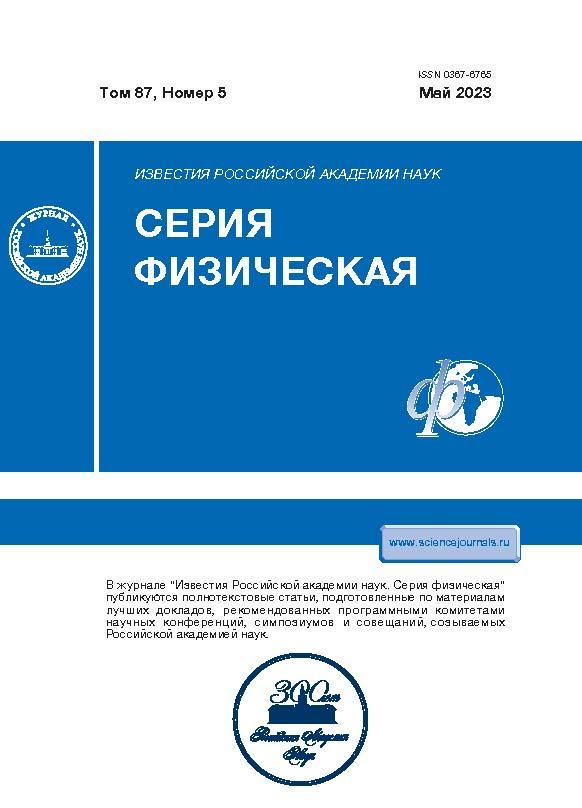Рентгенофлуоресцентный анализ с использованием синхротронного излучения для исследования сибирских кустарников урбоэкосистемы
- Авторы: Лях Е.М.1, Храмова Е.П.1, Луговская А.Ю.1,2, Ракшун Я.В.3, Сороколетов Д.С.3
-
Учреждения:
- Федеральное государственное бюджетное учреждение науки “Центральный сибирский ботанический сад Сибирского отделения Российской академии наук”
- Федеральное государственное бюджетное образовательное учреждение высшего образования “Сибирский государственный университет геосистем и технологий”
- Федеральное государственное бюджетное учреждение науки “Институт ядерной физики имени Г.И. Будкера Сибирского отделения Российской академии наук”
- Выпуск: Том 87, № 5 (2023)
- Страницы: 726-732
- Раздел: Статьи
- URL: https://jdigitaldiagnostics.com/0367-6765/article/view/654413
- DOI: https://doi.org/10.31857/S0367676522701198
- EDN: https://elibrary.ru/AADOAY
- ID: 654413
Цитировать
Полный текст
Аннотация
Исследован элементный состав трех кустарников двух родов Spiraea и Myricaria, растущих в урбоэкосистеме г. Новосибирска и фоновых условиях методом рентгенофлуоресцентного анализа с использованием синхротронного излучения. Установлено не менее 20 элементов. Наиболее сильное загрязнение тяжелыми металлами в городских условиях отмечено у растений Myricaria bracteata. Более толерантная к загрязнению в городских условиях Spiraea chamaedryfolia может быть рекомендована для использования в качестве стандарта, а M. bracteata рекомендуется в качестве растения биоиндикатора загрязнения окружающей среды. Данные, полученные по элементному составу образцов растений и почв, могут быть включены в базы данных.
Об авторах
Е. М. Лях
Федеральное государственное бюджетное учреждение науки“Центральный сибирский ботанический сад Сибирского отделения Российской академии наук”
Автор, ответственный за переписку.
Email: llyakh@rambler.ru
Россия, Новосибирск
Е. П. Храмова
Федеральное государственное бюджетное учреждение науки“Центральный сибирский ботанический сад Сибирского отделения Российской академии наук”
Email: llyakh@rambler.ru
Россия, Новосибирск
А. Ю. Луговская
Федеральное государственное бюджетное учреждение науки“Центральный сибирский ботанический сад Сибирского отделения Российской академии наук”; Федеральное государственное бюджетное образовательное учреждение высшего образования
“Сибирский государственный университет геосистем и технологий”
Email: llyakh@rambler.ru
Россия, Новосибирск; Россия, Новосибирск
Я. В. Ракшун
Федеральное государственное бюджетное учреждение науки“Институт ядерной физики имени Г.И. Будкера Сибирского отделения Российской академии наук”
Email: llyakh@rambler.ru
Россия, Новосибирск
Д. С. Сороколетов
Федеральное государственное бюджетное учреждение науки“Институт ядерной физики имени Г.И. Будкера Сибирского отделения Российской академии наук”
Email: llyakh@rambler.ru
Россия, Новосибирск
Список литературы
- Rodrigues E.S., Gomes M.H.F., Duran N.M. et al. // Front. Plant Sci. 2018. V. 9. Art. No. 1588.
- Trunova V.A., Sidorina A.V., Zolotarev K.V. // X-ray Spectrum. 2015. V. 44. No. 4. P. 226.
- Piminov P.A., Baranov G.N., Bogomyagkov A.V. et al. // Phys. Procedia. 2016. V. 84. P. 19.
- Дарьин А.В., Ракшун Я.В. // Науч. вестн. Новосиб. гос. техн. ун-та. 2013. № 2(51). С. 112.
- Васильева И.Е., Шабанова Е.В. // ЖАХ. 2021. Т. 76. № 2. С. 99; Vasil’eva I.E., Shabanova E.V. // J. Analyt. Chem. 2021. V. 76. No. 2. P. 137.
- Terzano R., Denecke M.A., Falkenberg G. et al. // Pure Appl. Chem. 2019. V. 91. No. 6. P. 1029.
- Terekhina N.V., Ufimtseva M.D. // Geogr. Environ. Sustain. 2020. V. 13. No. 1. P. 224.
- Чиндяева Л.Н., Томошевич М.А., Беланова А.П., Банаев Е.В. Древесные растения в озеленении сибирских городов. Новосибирск: Изд-во “Гео”, 2018. 457 с.
- Луговская А.Ю., Храмова Е.П., Лях Е.М., Карпова Е.А. // Вест. СГУГиТ. 2020. Т. 25. № 1. С.173.
- Обзор состояния окружающей среды в городе Новосибирске за 2019 год. Новосибирск, 2020. 100 с.
- Khramova E., Lyakh E., Chankina O. et al. // AIP Conf. Proc. 2020. V. 2299. Art. No. 070005.
- Арнаутов Н.А. Стандартные образцы химического состава природных минеральных веществ. Методические рекомендации. Новосибирск, 1990. 220 с.
- Касимов Н.С., Власов Д.В., Кошелева Н.Е., Никифорова Е.М. Геохимия ландшафтов Восточной Москвы. М.: АПР, 2016. 276 с.
- Конарбаева Г.А. // Мат. всерос. научн. конф. с международ. участием “Почвы в биосфере” (Томск, 2018). С. 269.
- Ильин В.Б., Сысо А.И. Микроэлементы и тяжелые металлы в почвах и растениях Новосибирской области. Новосибирск: Изд-во СО РАН, 2001. 231 с.
- Ильин В.Б., Сысо А.И., Байдина Н.Л. и др. // Почвоведение. 2003. № 5. С. 550.
- Семендяева Н.В., Галеева Л.П., Мармулев А.Н. Почвы Новосибирской области и их сельскохозяйственное использование: учеб. пособие. Новосибирск: НГАУ, 2010. 187 с.
Дополнительные файлы











